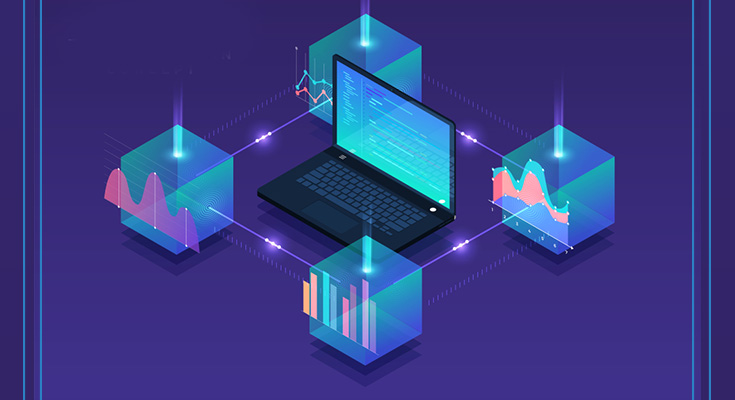Blockchain technology has been around for a long time, and it is still growing. A lot of people wonder how does blockchain secure data and how blockchain works. Regardless of all its benefits, there are a lot of mixed feelings towards blockchain technology. It doesn’t matter how mixed the reviews of the technology are, the role of blockchain against fraud and the role in the global economic landscape is great.
The growth of blockchain first came into the limelight with the rise of Bitcoin. If you’re not into cryptocurrency, you should know about the blockchain for fraud prevention.
How Blockchain Works?
At first glance, blockchain looks complicated, but the core concept of how blockchain works is really simple. A blockchain is a type of database, to completely understand what is blockchain technology, you need to understand what is a database.
A database is a collection of information that’s stored on a computer system. Any information that’s stored on a database is stored in a table-type manner for easier searching and filtering of data. Now you may wonder, what is the difference between a spreadsheet and a database.
The major difference between a spreadsheet and a database is that a spreadsheet is made for a single person or a small group of people. These people can store and access limited information. In comparison to that, a database is designed to store much larger amounts of information, that can be quickly accessed, filtered, and changed quickly by any number of users at the same time.
Huge databases achieve this functionality by using data on servers that are built on powerful computers. While a spreadsheet database can be accessed by several people, it is often owned by businesses. Now that you understand what is a database, we can move on to “how does blockchain secure data”.
How Does Blockchain Secure Data?
One of the major differences between a typical database and a blockchain is the way the data is structured. A blockchain collects information together in groups that are known as blocks, these blocks hold a set of information. Blocks have a specific amount in which information can be stored, when the storage is filled, they are chained to the previously connected blocks, all of which form a chain of data, which is known as the blockchain.
So the question remains, how does blockchain secure data? Major blockchain features and benefits account for the issues of security and trust in multiple ways. First, new blocks are always stored linearly and chronologically. The new information is always added to the “end” of the blockchain.
After a new block has been ended to the back of the blockchain, it is almost impossible to go back and alter the contents of the block unless it is the major consensus to do so. The reason it is considered secure is that it each block contains its own hash, alongside the hash of the block before. A hash code is built using a mathematical function that turns information into a string of numbers and letters. This is how blockchain works in banking and other financial transactions like bitcoins.
Types of Identity Theft
Another common type of online fraud is identity theft, the growing rate of identity theft is alarming. Most people aren’t even aware that their identity has been stolen after the damage has been done. Now that we know how does blockchain secures data, we can discuss how blockchain prevents identity theft. Here are the most common types of identity thefts.
1. Driver’s License Identity Theft
Anyone that has access to your driving license can make use of your sensitive information and commit fraudulent activities. They can open credit card accounts or use the stolen identity theft if caught for reckless driving.
2. E-Commerce Fraud
Online identity theft is basically cybercriminals stealing your information like payment details and credentials. Using this information, these criminals can make all kinds of unauthorized transactions. All these transactions will end up hurting your bank balance. This is one of the most common types of identity theft.
3. Mail Identity Theft
Your mailbox can be vulnerable to all kinds of cyberattacks. One out of 3 identity theft is done via email. Your mailbox contains all kinds of sensitive information including bank information, several login details, or insurance data. This crucial information can be used for all kinds of fraudulent information.
4. Social Security Number Theft
The social security number is provided to a citizen from the time of their birth. The nine-digit number contains information like financial records, including bank details and a person’s earnings. Now imagine someone gets hold of your social security number, they can use the information for all kinds of purposes.
If they can use your financial information, they can fill in fake account opening forms or even withdraw money from a person’s account using social security number. More than that, attackers can use your social security number to gain a tax refund. Social security number theft is another common type of identity theft.
5. Synthetic Identity Theft
Synthetic identity theft is a tricky type of identity theft. It is where an attacker mixes stolen information with fake details to create a new fake identity for committing a crime. This newly made identity can then be used to execute all kinds of fraudulent practices.
How Blockchain Prevent Identity Theft?
Identity theft is a part of online fraud, and it is growing at an alarming pace. A lot of people nowadays are aware of data breaches, but not many are aware that identity theft occurs every two seconds around the globe. In this perilous time, the need for securing one’s identity is crucial, and the way to do that is by safeguarding your documents. Now that you know about types of identity theft, here’s how blockchain prevents identity theft.
Blockchain against fraud technology has been taken into consideration since the rise of cybersecurity. The incredible technology holds brilliant potential for securing sensitive data from malicious activities.
Since blockchain contains digital assets including documents that are secured via powerful cryptographic keys. This is one of the primary reasons why it is harder for attackers to manipulate information stored in the blockchain. The data is stored on multiple computers on a blockchain network, so if someone wants to access crucial information, they will have to gain access on all computers which is almost impossible in all cases. Even if the hackers happen to gain access to data, any change they make to the data will be highlighted in the information. This is what blockchain unique and suitable to secure data. Now you know how blockchain prevents identity theft.
Storing any identity information on a blockchain will help both government and the public to prevent identity theft. This is how blockchain works, and the blockchain features and benefits are slowly causing it to come into mainstream adoption.
While blockchain is still a growing technology, it has countless possibilities for securing data. As the current measures for identity information storage are being attacked and breached, the use of blockchain for fraud prevention is at an all-time high.
Blockchain Features And Benefits
1. Blockchain Is Distributed
A blockchain is a type of distributed digital ledger which contains transaction data that is hosted on a peer-to-peer network. There is no centralized administrator so there’s no one point of failure that can be accessed for information breach. Instead of a single point, the management and authorization are spread all over the network.
2. Blockchain Is Unyielding
Another blockchain feature and benefit is that any transaction or information recorded on the blockchain is unchangeable as the information can’t be deleted or changed. While you can create a new transaction to change the state of any asset, the new information will just be added to the chain.
3. Blockchain can be Permissioned
Businesses of all kinds tend to deal with a lot of confidential data and they can’t have just about anyone access the vital information. So they have to find some way to make sure that outsiders can’t access their data. This is where permissions come into play. You should know that not all blockchain is permissioned. This is why permission networks can be a great solution for fraud prevention because they can restrict who can access the data.
How DIRO Makes Use of Blockchain For Document Verification?
Till now we have discussed, how does blockchain secure data, how blockchain work, the types of identity theft, and how blockchain prevent identity theft. A major part of all the information and the data breach are documented, most of the online frauds are conducted by using fake or tempered documents.
A person who steals an identity can open a new bank account and use that bank account for many fraudulent activities. That’s where the innovative technology for document verification by DIRO comes in. It verifies any online original information on the web with automatic user consent and impersonation checks. You can verify any bank statements, proof of address, student certificates and so much more.
Once DIRO verifies a piece of information, it provides a trusted certificate that ensures a document is original. This original document can then be shared in the form of a PDF. DIRO provides the digital document with a unique hash, which then is placed on a blockchain. use this information to verify the documents that are already on the blockchain.
So banks, financial institutions, and others can drop this PDF into DIRO’s verification engine, which verifies the information against the blockchain. DIRO’s original documents are much more secure to share as the information can’t be tampered with by attackers or anyone else. Organizations can use DIRO’s software to minimize online fraud.







